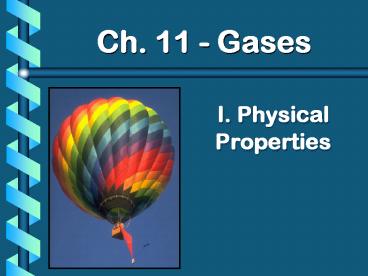I. Physical Properties PowerPoint PPT Presentation
1 / 32
Title: I. Physical Properties
1
I. Physical Properties
- Ch. 11 - Gases
2
Kinetic Molecular Theory
- Particles in an ideal gas
- have no volume.
- have elastic collisions.
- are in constant, random, straight-line motion.
- dont attract or repel each other.
- have an avg. KE directly related to Kelvin
temperature.
3
Real Gases
- Particles in a REAL gas
- have their own volume
- attract each other
- Gas behavior is most ideal
- at low pressures
- at high temperatures
- in nonpolar atoms/molecules
4
Characteristics of Gases
- Gases expand to fill any container.
- random motion, no attraction
- Gases are fluids (like liquids).
- no attraction
- Gases have very low densities.
- no volume lots of empty space
5
Characteristics of Gases
- Gases can be compressed.
- no volume lots of empty space
- Gases undergo diffusion effusion.
- random motion
6
Temperature
- Always use absolute temperature (Kelvin) when
working with gases.
7
Pressure
Which shoes create the most pressure?
8
Pressure
- Barometer
- measures atmospheric pressure
9
Pressure
- Manometer
- measures contained gas pressure
10
Pressure
- KEY UNITS AT SEA LEVEL
- 101.325 kPa (kilopascal)
- 1 atm
- 760 mm Hg
- 760 torr
- 14.7 psi
11
STP
STP
12
Boyles Law
PV k
13
Boyles Law
- The pressure and volume of a gas are inversely
related - at constant mass temp
PV k
14
Charles Law
15
Charles Law
- The volume and absolute temperature (K) of a gas
are directly related - at constant mass pressure
16
Gay-Lussacs Law
17
Gay-Lussacs Law
- The pressure and absolute temperature (K) of a
gas are directly related - at constant mass volume
18
Combined Gas Law
P T
V T
PV T
k
PV
P1V1T2 P2V2T1
19
Gas Law Problems
- A gas occupies 473 cm3 at 36C. Find its volume
at 94C.
CHARLES LAW
GIVEN V1 473 cm3 T1 36C 309K V2 ? T2
94C 367K
WORK P1V1T2 P2V2T1
T?
V?
(473 cm3)(367 K)V2(309 K) V2 562 cm3
20
Gas Law Problems
- A gas occupies 100. mL at 150. kPa. Find its
volume at 200. kPa.
BOYLES LAW
GIVEN V1 100. mL P1 150. kPa V2 ? P2
200. kPa
WORK P1V1T2 P2V2T1
P?
V?
(150.kPa)(100.mL)(200.kPa)V2 V2 75.0 mL
21
Gas Law Problems
- A gas occupies 7.84 cm3 at 71.8 kPa 25C. Find
its volume at STP.
COMBINED GAS LAW
GIVEN V1 7.84 cm3 P1 71.8 kPa T1 25C
298 K V2 ? P2 101.325 kPa T2 273 K
WORK P1V1T2 P2V2T1 (71.8 kPa)(7.84 cm3)(273
K) (101.325 kPa) V2 (298 K) V2 5.09 cm3
P? T?
V?
22
Gas Law Problems
- A gas pressure is 765 torr at 23C. At what
temperature will the pressure be 560. torr?
GAY-LUSSACS LAW
GIVEN P1 765 torr T1 23C 296K P2 560.
torr T2 ?
WORK P1V1T2 P2V2T1
P?
T?
(765 torr)T2 (560. torr)(296K) T2 217K -56C
23
Avogadros Principle
- Equal volumes of gases contain equal numbers of
moles - at constant temp pressure
- true for any gas
24
Ideal Gas Law
Merge the Combined Gas Law with Avogadros
Principle
PV T
- V
- n
PV nT
R
UNIVERSAL GAS CONSTANT R0.0821 L?atm/mol?K
25
Ideal Gas Law
PVnRT
UNIVERSAL GAS CONSTANT R0.0821
L?atm/mol?K R8.315 dm3?kPa/mol?K
You dont need to memorize these values!
26
Ideal Gas Law Problems
- Calculate the pressure in atmospheres of 0.412
mol of He at 16C occupying 3.25 L.
GIVEN P ? atm n 0.412 mol T 16C 289 K V
3.25 L R 0.0821L?atm/mol?K
WORK PV nRT P(3.25)(0.412)(0.0821)(289)
L mol L?atm/mol?K K P 3.01
atm
27
Ideal Gas Law Problems
- Find the volume of 85 g of O2 at 25C and 104.5
kPa.
GIVEN V ? n 85 g T 25C 298 K P
104.5kPa1.031 atm R 0.0821 Latm/mol?K
2.7 mol
PV nRT (1.031)V(2.7) (0.0821) (298) atm
mol L?atm/mol?K K V 64.071L 64 L
(s/fs)
28
Gas Stoichiometry
- Moles ? Liters of a Gas
- STP - use 22.4 L/mol
- Non-STP - use ideal gas law
- Non-STP
- Given liters of gas?
- start with ideal gas law
- Looking for liters of gas?
- start with stoichiometry conv.
29
Gas Stoichiometry Problem
- What volume of CO2 forms from 5.25 g of CaCO3
at 103 kPa 25ºC?
CaCO3 ? CaO CO2
5.25 g
? Lnon-STP
Looking for liters Start with stoich and
calculate moles of CO2.
1 mol CaCO3 100.09g CaCO3
5.25 g CaCO3
1 mol CO2 1 mol CaCO3
1.26 mol CO2
Plug this into the Ideal Gas Law to find liters.
30
Gas Stoichiometry Problem
- What volume of CO2 forms from 5.25 g of CaCO3
at 103 kPa 25ºC?
WORK PV nRT (103 kPa)V(1mol)(8.315dm3?kPa/mol
?K)(298K) V 1.26 dm3 CO2
GIVEN P 103 kPa V ? n 1.26 mol T 25C
298 K R 8.315 dm3?kPa/mol?K
31
Gas Stoichiometry Problem
- How many grams of Al2O3 are formed from 15.0 L of
O2 at 97.3 kPa 21C?
4 Al 3 O2 ? 2 Al2O3
15.0 L non-STP
? g
WORK PV nRT (97.3 kPa) (15.0 L) n
(8.315dm3?kPa/mol?K) (294K) n 0.597 mol O2
GIVEN P 97.3 kPa V 15.0 L n ? T 21C
294 K R 8.315 dm3?kPa/mol?K
Given liters Start with Ideal Gas Law and
calculate moles of O2.
NEXT ?
32
Gas Stoichiometry Problem
- How many grams of Al2O3 are formed from 15.0 L of
O2 at 97.3 kPa 21C?
4 Al 3 O2 ? 2 Al2O3
15.0L non-STP
? g
Use stoich to convert moles of O2 to grams Al2O3.
2 mol Al2O3 3 mol O2
0.597 mol O2
101.96 g Al2O3 1 mol Al2O3
40.6 g Al2O3

